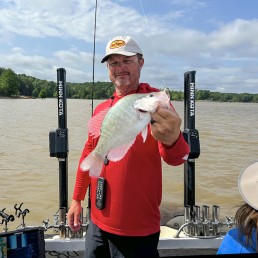Trolling Jigs for Crappies
SHARE THIS POST
Trolling jigs, also called pulling and long lining, is a fun and productive way to fish. Multiple poles and baits (often determined by state regulations) are pulled through the water to catch crappies and other species. It sounds easy, but key factors lead to success or failure. A pulling expert shares how he catches more crappies.
The gear
Brad Chappell, professional guide in Mississippi and host of Crappie Connection podcast says the number one tool for trolling is a wireless trolling motor. It allows you to maintain a constant speed in every condition. Set a direction, and the motor does the guiding. You can catch a fish while the boat maintains the right course. The trolling motor can be controlled from anywhere in the boat.
Electronics are another tool. The more you can see fish, the more fish you can catch. He uses Side Imaging, Down Imaging and mapping. However, he says trolling is something you can do with a very basic sonar unit and paper map.
“My poles are B‘n’M Pro Staff Trollers,” says Chappell. “I use different lengths but keep the action the same for all poles. I use 8-, 12-, and 18-foot poles because those lengths give good line separation. All poles are horizontal to the water with their tip height about a foot or two from the water’s surface. A pole tip kept lower to the water has less wind and fewer waves bothering the line. I use Driftmaster rod holders.
“I keep everything consistent by spooling all reels with 6-pound-test monofilament line. I alternate colors on alternate poles, using clear and high-vis lines, because it helps untangle lines when they tangle. My baits are Bobby Garland Stroll-R baits because I like the available colors and their vibration. I use 1/32- to 1/8-ounce jigs in tandem. I like Road Runner heads and use them most of the time for the flash and vibration.”
Catching fish
Trolling begins by going to an area where fish should be at the time of year you’re fishing. Chappell uses Side Imaging to see where fish are in the water column and to learn if shad are in the area. Shad are important any time of year. He wants to see them in tight balls because that means they are scared and being chased. If they are scattered, that means they are not scared or distressed.
“I’ll cast my shortest pole, put it in the holder and let it tighten up. I’ll cast my second pole and so on. I’m always asked how many feet of line to use, but it’s simple: a good cast. For me, it’s about 70 to 80 feet. I don’t care if I’m not exact, but I know I will be close. Also, not all fish are at the same depth. After I get all my lines out, the boat doesn’t stop until all jigs are returned to the boat.”
Chappell considers himself to be opposite of most fishermen because he likes to start by trolling fast. He says that most people start slow, but he wants to cover as much water as possible to find the most active fish. If going fast doesn’t work, he slows down to whatever speed the crappies want. He starts at 1.2 mph and seldom goes slower than 0.8 mph.
Are you enjoying this post?
You can be among the first to get the latest info on where to go, what to use and how to use it!
When lines are out the same length and bait weights are the same, depth is controlled by speed. Other factors include line diameter and the water resistance of baits, but the primary factor is boat speed. He uses two jigs in tandem tied with loop knots, with a 1-inch loop on bottom and 4-inch loop on top. He measures from his shoe to his belt for jig separation.
“Baits are important. Whatever brand and type you choose, stick to only one body style for best depth consistency. I also use willow-leaf blade jigheads most of the time.
“If I’m not catching fish, I’ll start changing jig sizes to put my lures in a different depth range. I’ll look at my electronics to find baitfish in tight pods. Changing colors can make a huge difference, too. My baits are not trying to coax a bite but rather trigger a reaction bite.”
Where to fish is always a concern to most fishermen. It’s best to read lake fishing reports and ask a few questions at bait shops and at the ramp. Try to learn the depth of the fish and a general area of the lake. Knowing the hot bait color is also good.
Chappell prefers to find an area and start following contour lines. For example, he fishes a contour line at 12 feet that has fish at 8 feet. He doesn’t like open-water fish just swimming around everywhere because they are difficult to pattern. He wants to find a contour line they are using and follow it.
Looking for some new fishing techniques to try this season? You’ll find plenty of suggestions in every issue of MidWest Outdoors. Subscribe on our website.
MWO
SHARE THIS POST
You may also like...
Nothing found.
Did you enjoy this post?
You can be among the first to get the latest info on where to go, what to use and how to use it!
Tim Huffman
Tim Huffman specializes in crappie fishing, is editor for two crappie magazines, as well as writing for several others. In 2018, he published his sixth book, Limiting Out for Crappie, available at Amazon. His first article appeared in MidWest Outdoors in 1988.
